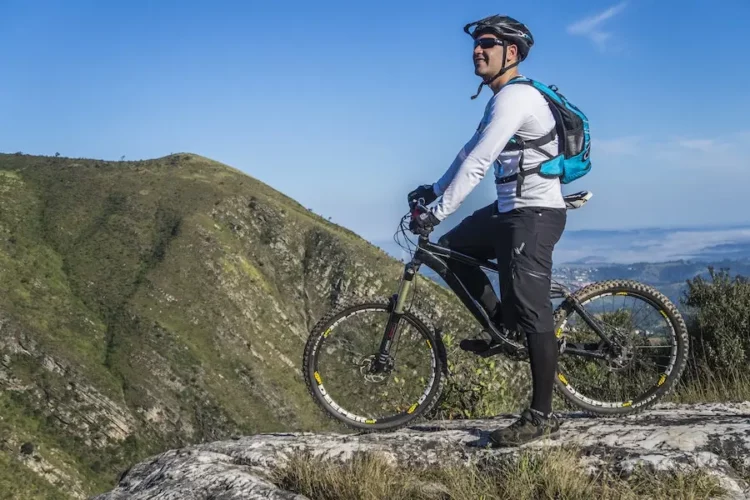Although the suspension is a common feature of mountain bikes to help you maintain control over uneven terrain, not all mountain riders require the same type or amount of suspension. Full suspension mountain bikes have front and rear shocks, whereas hardtail mountain bikes only have a rear shock.
Though they might cost the same because of the variety of pricing points and build options, there are many reasons why a biker would pick one over the other. Hardtails typically cost less than full-suspension bicycles, but you can pick between the two when prices are equal. The answer depends on both the value as well as riding technique.
Full-Suspension Bikes
Full suspension road bikes start at around $2,000 for entry-level models. It’s a terrific option and will get you a more versatile bike if your budget allows it. The pros and cons of this bike are given below:
Pros
Full-suspension bikes look great, especially when a coil shock is added. The heavy metal spring seems tough and durable. With your frame, you may also determine the color of the spring.
It is highly advanced. High-tech shock absorbers and full-suspension frames take a lot of time to create. Modern electric mountain bike full suspension now comes with highly developed suspension systems. Engineers are constantly enhancing their performance.
Full-suspension bikes are far more comfortable to ride on rough terrain thanks to the rear shock. A full-sus is the best option if you want to forge your own path through the rugged terrain and venture as far off the beaten path as possible while maintaining control.
Full-sus is also an excellent option for novice riders because you will not have to be as particular about the trail path you choose.
You can maintain momentum through tricky areas of the path since the front and back suspensions smooth out bumps. A hardtail may go faster on the flatter sections but slow down on the more difficult ones.
You can overcome obstacles more quickly because of the nimble rear’s increased grip in full-sus. You may catch pace with more experienced riders since the rear suspension aids in reducing rider fatigue by absorbing a lot of the off-road vibration.
Also, a full-sus will be a far more accommodating ride if you have any past injuries or knee, lower back, or ankle problems. It can muffle trail chatter in addition to absorbing heavier impacts when you hit a jump or drop-off wrong, protecting your ankles as well as hips from injury.
Cons
Full-suspension bikes are generally difficult to repair. Getting your full-suspension frame welded may or may not be an option if it cracks. Consider getting the problem fixed by a professional. A repair may impact your suspension system’s performance.
They have lower durability. More parts can fail since there are more moving parts. If it’s not set up correctly, it can harm a shock. Full-suspension bikes aren’t resilient to hard impacts.
They weigh a lot more. The bearings, rear shock absorber, bushings, and more intricate frame construction increases the bike’s weight. With a heavier bike, acceleration and ascent need more effort. It’s a little more challenging to control and turn as well.
Hardtail Mountain Bikes
With a hardtail, you typically receive more bikes for your money, especially when your budget is $1,500 or less. Hardtails are less expensive to produce since they have a more straightforward design. The pros and cons of riding this bike are as follows:
Pros
Any hardtail is significantly less expensive to acquire if you are worried about the cost of future bike maintenance or live in an area where muddy rides seem common. If you frequently ride in muddy conditions, full-suspension bikes need linkage bearing replacements and shock servicing, which can quickly drive up the cost of ownership.
A hardtail can be a good choice if you’ll be riding primarily on smooth trails like single-track country roads or gravel. Also, for riders who ride a mountain bike as a general-purpose cycling machine, the hardtail is more flexible.
It creates a significantly better commuter bike and is simple to modify for touring. If they have the right geometry and a good suspension fork, hardtails can be entertaining on slightly tricky descents.
Due to its simpler construction and fewer moving components than full-suspension bikes, hardtail mountain bikes typically weigh less. A lighter load may be advantageous if your ride involves hills or lengthy distances. More expensive full suspension bikes might be reasonably light, so the weight difference may not be noticeable if you’re prepared to pay the money.
Cons
The truth is that a hardtail might be difficult on your body if you have any past injuries, lower back problems, or knee/ankle problems.
It works less well on rough ground. On a rugged trail, a hardtail bike’s back tire hops up off trees and rocks instead of rolling over. If you’ve ever driven on a rutted gravel road, you’ll be familiar with how tiring rear-wheel terrain vibration might be after an hour.
If you hold it down on the brakes, they push your bike up, which slows down its forward motion. It takes work to get the bike going again.
On a hardtail mountain bike, you can only modify the forks. You may not make any changes because the frame is completely rigid. Not much will change about how well the bike rides.
Final Words
Consider a full-suspension bike if you’re just beginning mountain riding for fun or adventure. It will reward risk-taking riders, and you’ll truly value it as you go downhill. On the other hand, a hardtail will be wonderful if you start mountain biking for an aerobic workout.
Hardtails are excellent for making significant climbing efforts and moving quickly over terrain. However, they might not be as forgiving as a full-sus bike over more challenging terrain. Select a somewhat heavier full-suspension bike if you are seeking an all-around, more competent, and comfortable ride.







